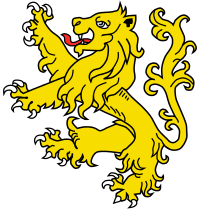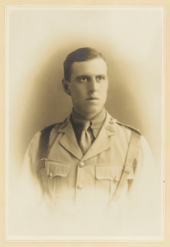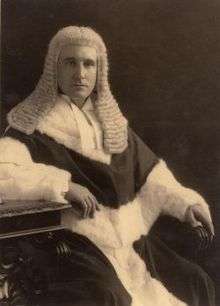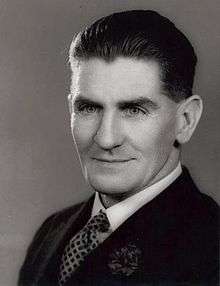Street family
| Street | |
|---|---|
 | |
| Current region | Australia |
| Place of origin | United Kingdom |
| Members | |
| Motto |
"Fideli cum fidelis" (Faithful among the faithless) |
The Street family is a prominent Australian legal, political and military family. The Streets are the only dynasty in Australian history with three consecutive vice-regal appointments to their name. Sir Philip Whistler Street, his son Lieutenant-Colonel Sir Kenneth Whistler Street and grandson Commodore Sir Laurence Whistler Street each attained the offices of Chief Justice of the Supreme Court of New South Wales and Lieutenant-Governor of New South Wales.
The first of the family to enter Australian politics was John Street, a New South Wales politician and businessman who descended from a 17th-century English judge, Sir Thomas Street.[1] John would succeed Australia's first Prime Minister Sir Edmund Barton in his parliamentary seat of East Sydney. John's son Sir Philip was the first wholly Australian-trained lawyer to be appointed as Chief Justice of the Supreme Court of New South Wales, the nation's first Supreme Court. The appointment of Sir Kenneth as a judge of the Court on 7 October 1931 also made Australian history for the first and only time a father and son have sat on the same bench as judges together, his father Sir Philip having been Chief Justice at the time.[1]
Sir Laurence's two eldest children are currently federal Australian judges and members of the Australian naval high-command, namely Justice Alexander "Sandy" Street and Justice Sylvia Emmett, the latter also being the wife of Justice Arthur Emmett, a federal Australian judge and Challis Lecturer in Roman Law at Sydney Law School. The ABC Dynasties series notes: "Among the great and powerful of the law, no family sits higher than the Streets. They've been at the forefront of the legal establishment for over a century."[2]
1st generation

John Rendell Street, MLC was an Australian politician and businessman. He was the first Australian generation of the Streets to enter Australian politics. He served as the successor of Sir Edmund Barton, 1st Prime Minister of Australia, in his New South Wales Legislative Assembly seat of East Sydney. John Street held this office until his death on the 23rd of March, 1891.[3] John Street had seven children by Susanna Caroline (née Lawson), a granddaughter of the politician and explorer William Lawson. The second son of John and Susanna was (Sir) Philip Whistler Street.[4]

2nd generation
Sir Philip Whistler Street, KCMG, KC (1863–1938) was the eighth Chief Justice of the Supreme Court of New South Wales and Lieutenant-Governor of New South Wales. On 24 July 1906 he was appointed as an acting judge of the Supreme Court and on 11 February 1907 he was made a full judge. He became Chief Justice on 28 January 1925 and held that office until his seventieth birthday in 1933.
He is the second longest serving judge in New South Wales history. He was appointed Lieutenant-Governor of New South Wales in 1930, and administered the state in the absence of the Governor of New South Wales from May to October 1934, January to February 1935, and January to August 1936. He died in 1938 and was buried with a state funeral at St Andrew's Cathedral. The second son of Sir Philip and Belinda Maud (née) Poolman was Lieutenant Laurence Whistler Street, and the eldest was (Sir) Kenneth Whistler Street.[5]

3rd generation

Lieutenant Laurence Whistler Street (1894-1915) was 21 years of age when he was killed in action May 1915 at Gallipoli fighting for the Allied forces in World War I. A student of Sydney Law School, he was an officer of the 3rd Battalion of the 1st Infantry Brigade. He volunteered for active wartime service in August 1914, making him one of the first of his generation to do so.[6]
Lieutenant-Colonel Sir Kenneth Whistler, KCMG, KStJ, QC (1890–1972) was elevated as a judge of the Supreme Court on 7 October 1931. He thus joined the bench of which his father, Sir Philip Whistler Street, was then Chief Justice. According to Percival Serle, this is the only known case in Australian history of a father and a son sitting as judges together on the same bench. In 1949, as senior puisne judge, Street acted as Chief Justice when Sir Frederick Richard Jordan died. He was confirmed in that office from 6 January 1950 and was sworn in on 7 February. Street was Lieutenant-Governor from 1950-1972. Prior to his career as a judge, he served the Allied forces in World War I, having been commissioned on 29 September 1914 in the Duke of Cornwall’s Light Infantry and sent to France. He ultimately rose to the rank of Lieutenant-Colonel in the Australian Army.
Like his father before him, he was buried with a state funeral at St Andrew's Cathedral, Sydney. Street House at Cranbrook School, Sydney is named in his honour.[7] Sir Kenneth's wife Lady "Red Jessie" Street was a prominent human rights activist. His eldest son (Sir) Laurence Street was named in honour of his brother's sacrifice at Gallipoli.
.jpg)
Lady "Red Jessie" Street (born Jessie Mary Grey Lillingston; 18 April 1889 – 2 July 1970) was the daughter of Charles Lillingston and Mabel Harriet Ogilvie, in turn the daughter of Australian politician Edward Ogilvie, MLC. She was an Australian suffragette who campaigned extensively for peace and human rights. Dubbed "Red Jessie" by her detractors in the right-wing media for her efforts to promote diplomacy with the USSR and to ease tensions during the Cold War, Jessie was a champion of the progressive cause.[8] She would be a key figure in Australian and international political life for over 50 years, from the women's suffrage struggle in England to the removal of Australia's constitutional discrimination against Aboriginal people in 1967.
Jessie was Australia's only female delegate to the establishment of the United Nations conference in San Francisco in 1945, where she played a key role alongside the likes of Eleanor Roosevelt in ensuring that gender was included as a non-discrimination clause, in addition to race and religion, in the United Nations Charter. She is recognised both in Australia and internationally for her activism. The Jessie Street Centre, the Jessie Street Trust, the Jessie Street National Women's Library and Jessie Street Gardens exist in her honour. [9]

Major Geoffrey Austin Street, MP, MC (21 January 1894 – 13 August 1940) was a cousin of Sir Kenneth's who served as Australia's Minister of Defence in the First Menzies Government during World War II. He was recognised with a Military Cross for his courage in serving the First Australian Imperial Force at the Battle of Gallipoli, where he was wounded before returning to active service in France during World War I. At the request of his close friend Sir Robert Menzies, Australia's longest serving Prime Minister, Street stood for and won the seat of Corangamite in 1934.
Street was made Minister of Defence in November 1938 and played a major role in the expansion of the military and munitions production prior to the outbreak of World War II and pushed the National Registration Act (1939) through parliament despite strong opposition. Following the outbreak of war, he worked tirelessly to put Australia on a war footing. In November 1939, Menzies abolished the position of Minister of Defence and appointed Street Minister for the Army and Minister for Repatriation. Street died while holding these offices in the 1940 Canberra air disaster, along with two other Cabinet ministers.[10]
4th generation

Commodore Sir Laurence Whistler Street, AC, KCMG, KStJ, QC (3 July 1926 - 21 June 2018) was the fourteenth and second youngest Chief Justice of the Supreme Court of New South Wales and Lieutenant-Governor of New South Wales. He was first appointed as a judge of the Supreme Court of New South Wales in the Equity Division. He was appointed Chief Justice and Lieutenant-Governor in 1974. Prior to his juridicial career, he served the Allied forces in World War II.
Sir Laurence first joined the Royal Australian Navy at age 17 and ultimately attained the rank of honorary Commodore of the Royal Australian Navy Reserve. After his juridicial career, he pioneered the practice of mediation and took up a range of offices, foremost as Chairman of Fairfax Media and Director of Monte dei Paschi di Siena, the oldest bank in the world.[11] Sir Laurence’s sister Philippa “Pip” Street married the Australian Test cricketer and journalist John "Jack" Henry Webb Fingleton, OBE in 1942.[12]
He was buried with a state funeral at the Sydney Opera House Concert Hall in July of 2018.[13] In a elegy before 700, incumbent Australian Prime Minister Malcolm Turnbull spoke of his mentor: "As a barrister, he was as eloquent as he was erudite, as formidable as he was fashionable […] Laurence had movie star good looks coupled with a charisma, charm and intellect, a humility, a humanity that swept all before him […] His nickname, Lorenzo the Magnificent, was well earned." The Prime Minister recalled how Sir Laurence had provided a reference for him to apply for a Rhodes Scholarship to the University of Oxford. Incumbent Australian Attorney General Mark Speakman hailed Sir Laurence as "a giant of the law in NSW".[14] Incumbent Chief Justice of Australia Tom Bathurst remembered Sir Laurence as "one of the outstanding jurists of the 20th Century."[15]
Susan Gai Watt, AM was the first wife of Sir Laurence Street and the first female chair of the Eastern Sydney Health Service (now amalgamated with Illawarra). She is the daughter of Ernest Alexander Stuart Watt (1874-1954), a Cambridge-educated shipowner, pastoralist and patron of the arts.[16] She is the niece of Australian aviator Oswald Watt, OBE, granddaughter of Australian politician John Brown Watt, MLC, and great-granddaughter of Australian politician George Holden, MLC.[17]
Anthony Austin Street, MP, the son of Geoffrey Austin Street, also represented the seat of Corangamite, from 1966 to 1983. His career culminated as Australia's Foreign Minister in the Fourth Fraser Ministry, from 1980 until 1983. In the Second Fraser Ministry he served as Minister for Employment and Industrial Relations, and Minister assisting the Prime Minister for Public Service Matters. During the Third Fraser Ministry he served as minister in several posts, including Minister for Employment and Industrial Relations and Minister for Industrial Relations. Prior to his career, he served in the Royal Australian Navy in World War I.[18]
Recent generations
By his first wife Susan Gai, Sir Laurence had four children: Kenneth, Sylvia, Alexander and Sarah.[19]
Kenneth Street is a NSW-based businessman. Kenneth has three children: Hamish Street, Isabella Street, a solicitor, and Matilda Street.
Justice Sylvia Emmett (née Street), a Sydney Law School graduate, is a judge of the Federal Circuit Court of Australia and a Lieutenant-Commander of the Royal Australian Naval Reserve.
Justice Arthur Emmett, AO, QC, the husband of Sylvia, was also a federal Australian judge and Challis Lecturer in Roman Law at Sydney Law School. Justice Arthur Emmett was appointed to the New South Wales Court of Appeal at a formal ceremony on Thursday, 7 March 2013 after serving as a judge of the Federal Court of Australia.
Justice Alexander "Sandy" Whistler Street, SC, is also a judge of the Federal Circuit Court of Australia and a Commander of the Royal Australian Naval Reserve. He has four children: Charles Street, a maritime lawyer at Norton Rose Fulbright Australia; Jack Street, also a law graduate; Lucy Street, and Heidi Street.
Sarah Whistler Farley (née Street) is Sir Laurence's youngest child by his first wife Susan. She holds a Bachelor of Arts from the University of Sydney and a Bachelor of Laws from Sydney Law School.
Jessie Street, a Sydney Law School graduate, is Sir Laurence's only child by his second wife Penelope, and god-daughter to Prince Charles of Wales.[20]
References
- 1 2 Karen Fox (17 February 2015). "Australian Legal Dynasties: The Stephens and the Streets". Australian Dictionary of Biography. National Centre of Biography, Australian National University. Retrieved 27 July 2018.
- ↑ "Dynasties: Street". Australian Broadcasting Corporation. Retrieved 25 January 2017.
- ↑ Mitchell Library, State Library of New South Wales: Street family - further papers, 1861 - 1972
- ↑ "Mr John Rendell Street (1832 - 1891)". Former Members. Parliament of New South Wales. 2008. Retrieved 5 July 2015.
- ↑ Bennett, J. M. Australian Dictionary of Biography. National Centre of Biography, Australian National University. Retrieved 5 May 2018 – via Australian Dictionary of Biography.
- ↑ "Obituary - Lawrence Whistler (Larry) Street - Obituaries Australia". oa.anu.edu.au. Retrieved 5 May 2018.
- ↑ Bennett, J. M. Australian Dictionary of Biography. National Centre of Biography, Australian National University. Retrieved 5 May 2018 – via Australian Dictionary of Biography.
- ↑ Coltheart, Lenore, '"Red Jessie": Jessie Street', in Uncommon Lives, National Archives of Australia, 2004, http://uncommonlives.naa.gov.au/jessie-street/.
- ↑ Radi, Heather. Australian Dictionary of Biography. National Centre of Biography, Australian National University. Retrieved 5 May 2018 – via Australian Dictionary of Biography.
- ↑ "Obituary - Geoffrey Austin Street - Obituaries Australia". oa.anu.edu.au. Retrieved 5 May 2018.
- ↑ "The Honourable Sir Laurence Whistler Street". www.supremecourt.justice.nsw.gov.au. Retrieved 5 May 2018.
- ↑ Wisden 1982 – Obituary – Jack Fingleton". Wisden. 1982. Retrieved 21 May 2007.
- ↑ https://www.afr.com/business/legal/sir-laurence-street-remembered-as-an-outstanding-jurist-20161013-gs1uzk
- ↑ https://www.afr.com/business/legal/sir-laurence-street-remembered-as-a-man-for-all-seasons-20180705-h12at2
- ↑ https://www.dailytelegraph.com.au/news/nsw/prime-minister-leads-tributes-at-state-funeral-for-former-chief-justice/news-story/9ee9bc39345ca285b6329895c7c7eb7d?memtype=anonymous
- ↑ Irving, T. H. Australian Dictionary of Biography. National Centre of Biography, Australian National University. Retrieved 5 May 2018 – via Australian Dictionary of Biography.
- ↑ UK Who's Who 2018 http://www.ukwhoswho.com/view/10.1093/ww/9780199540884.001.0001/ww-9780199540884-e-36525/version/8
- ↑ "Ministries and Cabinets". Parliamentary Handbook. Parliament of Australia. Archived from the original on 8 October 2012. Retrieved 25 July 2016.
- ↑ "Dynasties The Street Family ABC2 Television Guide". www.abc.net.au.
- ↑ https://www.smh.com.au/national/sir-laurence-street-the-very-model-of-a-modern-chief-justice-20180622-p4zn3f.html